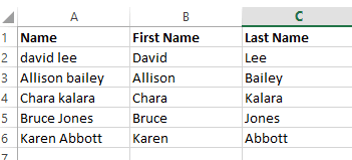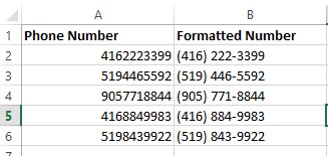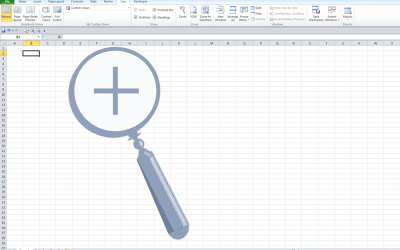4 Ways to Use Flash Fill in Excel to Extract, Combine, Clean or Format Data
by Avantix Learning Team | Updated September 15, 2023
Applies to: Microsoft® Excel® 2013, 2016, 2019, 2021 or 365 (Windows)
You can use Flash Fill in Excel to extract, combine, clean or format data quickly without using formulas. In order to use Flash Fill, Excel must be able to understand a pattern in a column to the left of the column where you want to fill the data so the source data should be entered in a consistent way. You can use Flash Fill by clicking a button, using shortcuts or by using the Fill handle. You run Flash Fill by entering an example of the data you want to fill using a "by example" logic.
You can automatically fill in values using Flash Fill if you have Microsoft Excel 2013 or a later version. Flash Fill can be used to extract names, phone numbers, emails and even to format data.
If you have a blank column between the column that is being flash filled and the column with the values being referenced, Excel will display a message that it cannot find a pattern in the adjacent data.
Although you may have used functions like LEFT, RIGHT and MID to extract data in previous versions of Excel, Flash Fill can extract data without using formulas. For example, if you have a column of full names and you wanted to extract the first and last names in separate columns, you could use Flash Fill.
Unlike formulas, Flash Fill does not update the generated data so if the original data changes, you would need to repeat the Flash Fill process.
Recommended article: No Mouse? Using Keyboard Only Navigation in Microsoft Office (Part 1: The Ribbon)
Do you want to learn more about Excel? Check out our virtual classroom or live classroom Excel courses >
1. Flash Fill with a keyboard shortcut
To use Flash Fill with a keyboard shortcut:
- Select a cell to the right of one or more columns of data you want to extract, combine, clean or format.
- Enter the example you want to extract, combine, clean or format (such as the first name from a cell in the same row in a column to the left). Flash Fill is case sensitive so enter the data in the desired case.
- Press Enter.
- In the cell below the first value, press Ctrl + E. Excel should generate data values from the adjacent column(s) to fill data in the cells in the current column.
2. Flash Fill using the Ribbon
To use Flash Fill using Flash Fill in the Ribbon:
- Select a cell to the right of one or more columns of data you want to extract, combine, clean or format.
- Enter the example you want to extract, combine, clean or format (such as the first name from a cell in the same row in a column to the left). Flash Fill is case sensitive so enter the data in the desired case.
- Press Enter.
- With the cell below the first value selected, click the Data tab in the Ribbon and click Flash Fill in the Data Tools group. Excel should generate data values from the adjacent column(s) to fill data in the cells in the current column.
Below is the Flash Fill command in the Ribbon:
3. Flash Fill using a drop-down menu
To use Flash Fill using a drop-down menu:
- Select a cell to the right of one or more columns of data you want to extract, combine, clean or format.
- Enter the example you want to extract, combine, clean or format (such as the first name from a cell in the same row in a column to the left). Flash Fill is case sensitive so enter the data in the desired case.
- Press Enter.
- In the cell below the first value, enter a new value (such as the first name from a cell in the same row in a column to the left). A pop-up of generated data should appear if Excel understands the pattern.
- Press Enter. Excel should generate data values from the adjacent column(s) to fill data in the cells in the current column.
If the data is not consistent, try the above method by entering three values.
4. Flash Fill using a Smart Tag
To use Flash Fill using a Smart Tag:
- Select a cell to the right of one or more columns of data you want to extract, combine, clean or format.
- Enter the example you want to extract, combine, clean or format (such as the first name from a cell in the same row in a column to the left). Flash Fill is case sensitive so enter the data in the desired case.
- Press Enter.
- Click the cell in which you entered the first value and drag the bottom right corner handle (Fill handle) down to the last cell you want to fill. A Smart Tag should appear.
- Click the Smart Tag and select Flash Fill.
Example 1: Extract first and last names using Flash Fill
If you have a column of names, you can extract first and last names in the adjacent columns as in the following example (column B and C data was generated using Flash Fill):
Example 2: Combine last names and first names using Flash Fill
If you have columns of first names and last names, you can reorganize the data as last name, comma and then first name or generate emails for people in the same company as in the following example (column C and D data was generated using Flash Fill):
Example 3: Format phone numbers using Flash Fill
You can use Flash Fill to format phone numbers by adding brackets not included in the original data as in the following example (column B data was generated using Flash Fill):
Example 4: Extract names from email addresses using Flash Fill
With Flash Fill, you can extract the text before the @ symbol from email addresses as in the following example (column B data was generated using Flash Fill):
These are just a few examples of Flash Fill to get you started. You can even use Flash Fill with date and time data so give it a try.
This article was originally published on January 31, 2016 and has been updated for clarity and content.
Subscribe to get more articles like this one
Did you find this article helpful? If you would like to receive new articles, JOIN our email list.
More resources
How to Freeze Row and Column Headings in Excel Worksheets
3 Excel Strikethrough Shortcuts to Cross Out Text or Values in Cells
How to Replace Blank Cells in Excel with Zeros (0), Dashes (-) or Other Values
How to Highlight Errors, Blanks and Duplicates in Excel Worksheets (Using Formulas)
10 Excel Flash Fill Examples (Extract, Combine, Clean and Format Data with Flash Fill)
Related training
Microsoft Excel: Intermediate / Advanced
Microsoft Excel: Data Analysis with Functions, Dashboards and What-If Analysis Tools
Microsoft Excel: Introduction to VBA (Visual Basic for Applications)
Our instructor-led courses are delivered in virtual classroom format or at our downtown Toronto location at 18 King Street East, Suite 1400, Toronto, Ontario, Canada (some in-person classroom courses may also be delivered at an alternate downtown Toronto location). Contact us at info@avantixlearning.ca if you'd like to arrange custom instructor-led virtual classroom or onsite training on a date that's convenient for you.
Copyright 2024 Avantix® Learning
You may also like
What is Power Query in Excel?
Power Query in Excel is a powerful data transformation tool that allows you to import data from many different sources and then extract, clean, and transform the data. You will then be able to load the data into Excel or Power BI and perform further data analysis. With Power Query (also known as Get & Transform), you can set up a query once and then refresh it when new data is added. Power Query can import and clean millions of rows of data.
How to Stop or Control Green Error Checking Markers in Excel
In Microsoft Excel, errors are flagged with small green marker or triangle in the upper left corner of the cell. However, these indicators display when there may be an error but is, in fact, not an error.
Excel Shortcuts to Zoom In and Out in Your Worksheets (4 Shortcuts)
There are several mouse and keyboard shortcuts you can use to zoom in and out in Excel worksheets. Some of these shortcuts are built-in and others can be created by customizing Excel Options.
Microsoft, the Microsoft logo, Microsoft Office and related Microsoft applications and logos are registered trademarks of Microsoft Corporation in Canada, US and other countries. All other trademarks are the property of the registered owners.
Avantix Learning |18 King Street East, Suite 1400, Toronto, Ontario, Canada M5C 1C4 | Contact us at info@avantixlearning.ca












